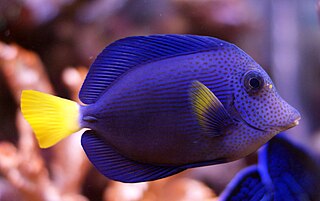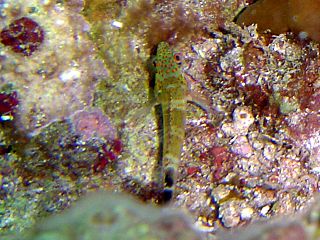
The Moorish idol is a species of marine ray-finned fish belonging to the family Zanclidae. It is the only member of the monospecific genus Zanclus and the only extant species within the Zanclidae. This species is found on reefs in the Indo-Pacific region.

The orbicular batfish, also known as the cooper batfish, circular batfish, orbiculate batfish, round batfish, narrow-banded batfish or orbic batfish is a species of marine ray-finned fish belonging to the family Ephippidae, the spadefishes and batfishes. This species is found in the Indo-Pacific but has been recorded outside its native range in the western Atlantic Ocean.

Scatophagidae, the scats are a small family of ray-finned fishes in the order Perciformes. They are found in the Indo-Pacific region but one species has been introduced elsewhere.

Scorpaena is a widespread genus of marine ray-finned fish belonging to the family Scorpaenidae, the scorpionfishes.

Micropogonias is a genus of marine ray-finned fishes belonging to the family Sciaenidae, the drums and croakers. These fishes are found in the eastern Pacific and western Atlantic Oceans.

Platycephalus is a genus of mostly marine, demersal ray-finned fish belonging to the family Platycephalidae. They are found in the eastern Mediterranean, the Indian Ocean and western Pacific Ocean.

Scatophagus argus, the spotted scat, butterfish, mia mia, spotted butterfish or tiger scat, is a species of fish in the scat family Scatophagidae. It occurs in two basic color morphs which are called green scat and ruby or red scat. This fish is generally distributed around the Indo-Pacific region, to Japan, New Guinea, and southeastern Australia. They live in coastal muddy areas, including estuaries, mangroves, harbours, and the lower courses of rivers. They are popular aquarium fish.

Caesionidae, the fusiliers, are a family of marine ray-finned fishes in the order Perciformes. The family includes about 23 species. They are related to the snappers, but adapted for feeding on plankton, rather than on larger prey. They are found at reefs in the Indo-Pacific and in the Red Sea.

Zebrasoma scopas, the brown tang, twotone tang, scopas tang or brush-tail tang, is a species of marine ray-finned fish belonging to the family Acanthuridae which includes the surgeonfishes, unicornfishes and tangs. The brown tang is found throughout Oceania and is a herbivorous fish, feeding predominantly on filamentous algae. It is a highly popular fish in the aquarium trade.

The sailfin tang, the Pacific sailfin tang, purple sailfinned tang or sailfin surgeonfish, is a marine ray-finned fish belonging to the family Acanthuridae which includes the surgeonfishes, unicornfishes and tangs. This fish is found in the Pacific Ocean and is popular in the aquarium hobby.

Zebrasoma xanthurum, the purple tang or yellowtail tang, is a species of marine ray-finned fish belonging to the family Acanthuridae which includes the surgeonfishes, unicornfishes and tangs. This species is endemic to the north western Indian Ocean.

Ctenochaetus strigosus, the kole tang, spotted bristletooth, spotted surgeonfish, goldring bristletooth, goldring surgeonfish, yelloweye tang or yellow-eyed surgeonfish, is a species of marine ray-finned fish belonging to family Acanthuridae which includes the surgeonfishes, unicornfishes and tangs. This fish is endemic to Hawaii.

Platax pinnatus, also known as the longfin batfish, pinnate spadefish, pinnate batfish, pinnatus batfish, dusky batfish, shaded batfish, or red-faced batfish is a species of marine ray-finned fish belonging to the family Ephippidae, the spadefishes and batfishes. This species is found in the western Pacific Ocean and occasionally is kept in marine aquariums.

The redspotted hawkfish is a species of marine ray-finned fish, a hawkfish belonging to the family Cirrhitidae. It is found at depths from 2 to 46 m on tropical reefs in the Western Atlantic. The Redspotted Hawkfish is also found in the aquarium trade.

Acanthurus thompsoni, the night surgeonfish, chocolate surgeonfish, Thompson's surgeonfish, Thompson's tang or whitetail surgeonfish, is a species of marine ray-finned fish belonging to the family Acanthuridae which includes the surgeonfishes, unicornfishes and tangs. This species has a wide Indo-Pacific distribution.

The streaked spinefoot, also known as the Java rabbitfish, blue-spotted spinefoot, blue-spotted trevally, Java spinefoot or white-spotted rabbit-fish, is a species of marine ray-finned fish, a rabbitfish belonging to the family Siganidae. It is found throughout most of the Indo-Pacific region.

Etelis is a genus of marine ray-finned fish belonging to the family Lutjanidae, the snappers. They are mostly native to the Indian and Pacific oceans with one species (E. oculatus) native to the western Atlantic Ocean.

The spotbanded scat,(Selenotoca multifasciata), also known as the striped scat, banded scat, barred scat, butterfish, John Dory, Johnny Dory, old maid, Southern butter-fish or striped butterfish, is a species of ray-finned fish, belonging to the family Scatophagidae, the scats. They are found in the eastern Indian Ocean and southwestern Pacific Ocean.

Scatophagus tetracanthus, the scatty or African scat is a species of ray-finned fish belonging to the family Scatophagidae, the scats. It is found in eastern Africa and Madagascar and in New Guinea and northern Australia.

Siganus spinus, the little spinefoot, scribbled rabbitfish, blunt-nosed spinefoot, spiny rabbitfish, or spiny spinefoot, is a species of marine ray-finned fish, a rabbitfish belonging to the family Siganidae. It is found in the Indo-Pacific region.





















